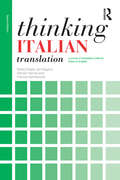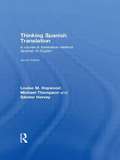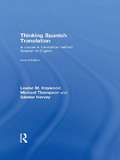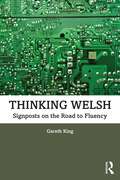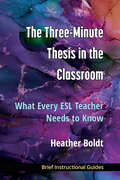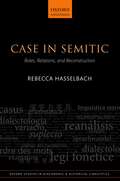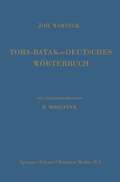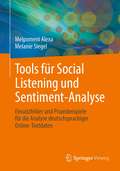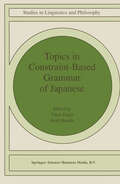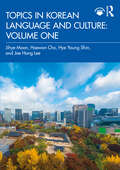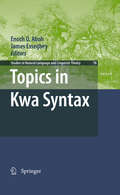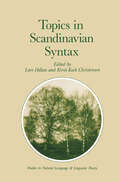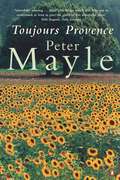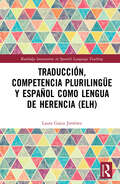- Table View
- List View
Thinking Italian Translation: A course in translation method: Italian to English (Thinking Translation)
by Stella Cragie Ian Higgins Sándor Hervey Patrizia GambarottaThinking Italian Translation is an indispensable course for students who want to develop their Italian to English translation skills. This new edition includes: up-to-date examples and new source texts from a variety of genres, from journalistic to technical. a brand new section on professionalism and the translation market The course is practical, addressing key issues for translators such as cultural differences, genre, and revision and editing. At the same time, it clearly defines translation theories. Thinking Italian Translation is key reading for advanced students wishing to perfect their language skills or considering a career in translation.
Thinking Spanish Translation: Spanish to English
by Louise Haywood Sándor Hervey Michael ThompsonThe new edition of this comprehensive course in Spanish-English translation offers advanced students of Spanish a challenging yet practical approach to the acquisition of translation skills, with clear explanations of the theoretical issues involved. A variety of translation issues are addressed, including: cultural differences register and dialect grammatical differences genre. With a sharper focus, clearer definitions and an increased emphasis on up-to-date 'real world' translation tasks, this second edition features a wealth of relevant illustrative material taken from a wide range of sources, both Latin American and Spanish, including: technical, scientific and legal texts journalistic and informative texts literary and dramatic texts. Each chapter includes suggestions for classroom discussion and a set of practical exercises designed to explore issues and consolidate skills. Model translations, notes and suggestions for teaching and assessment are provided in a Teachers' Handbook; this is available for free download at http://www. routledge. com/cw/thinkingtranslation/ Thinking Spanish Translationis essential reading for advanced undergraduate and postgraduate students of Spanish and translation studies. The book will also appeal to a wide range of language students and tutors through the general discussion of the principles and purposes of translation. 9781134070183 9780415481304 9780203886014 9780415440042
Thinking Spanish Translation: Spanish to English (PDF)
by Louise Haywood Sándor Hervey Michael ThompsonThe new edition of this comprehensive course in Spanish-English translation offers advanced students of Spanish a challenging yet practical approach to the acquisition of translation skills, with clear explanations of the theoretical issues involved. A variety of translation issues are addressed, including: cultural differences register and dialect grammatical differences genre. With a sharper focus, clearer definitions and an increased emphasis on up-to-date 'real world' translation tasks, this second edition features a wealth of relevant illustrative material taken from a wide range of sources, both Latin American and Spanish, including: technical, scientific and legal texts journalistic and informative texts literary and dramatic texts. Each chapter includes suggestions for classroom discussion and a set of practical exercises designed to explore issues and consolidate skills. Model translations, notes and suggestions for teaching and assessment are provided in a Teachers' Handbook; this is available for free download at http://www. routledge. com/cw/thinkingtranslation/ Thinking Spanish Translationis essential reading for advanced undergraduate and postgraduate students of Spanish and translation studies. The book will also appeal to a wide range of language students and tutors through the general discussion of the principles and purposes of translation. 9781134070183 9780415481304 9780203886014 9780415440042
Thinking Spanish Translation: Spanish to English
by Louise Haywood Michael Thompson Sándor HerveyThe new edition of this comprehensive course in Spanish-English translation offers advanced students of Spanish a challenging yet practical approach to the acquisition of translation skills, with clear explanations of the theoretical issues involved. A variety of translation issues are addressed, including: cultural differences register and dialect grammatical differences genre. With a sharper focus, clearer definitions and an increased emphasis on up-to-date ‘real world’ translation tasks, this second edition features a wealth of relevant illustrative material taken from a wide range of sources, both Latin American and Spanish, including: technical, scientific and legal texts journalistic and informative texts literary and dramatic texts. Each chapter includes suggestions for classroom discussion and a set of practical exercises designed to explore issues and consolidate skills. Model translations, notes and suggestions for teaching and assessment are provided in a Teachers’ Handbook; this is available for free download at http://www.routledge.com/cw/thinkingtranslation/ Thinking Spanish Translation is essential reading for advanced undergraduate and postgraduate students of Spanish and translation studies. The book will also appeal to a wide range of language students and tutors through the general discussion of the principles and purposes of translation.
Thinking Spanish Translation: Spanish to English
by Louise Haywood Michael Thompson Sándor HerveyThe new edition of this comprehensive course in Spanish-English translation offers advanced students of Spanish a challenging yet practical approach to the acquisition of translation skills, with clear explanations of the theoretical issues involved. A variety of translation issues are addressed, including: cultural differences register and dialect grammatical differences genre. With a sharper focus, clearer definitions and an increased emphasis on up-to-date ‘real world’ translation tasks, this second edition features a wealth of relevant illustrative material taken from a wide range of sources, both Latin American and Spanish, including: technical, scientific and legal texts journalistic and informative texts literary and dramatic texts. Each chapter includes suggestions for classroom discussion and a set of practical exercises designed to explore issues and consolidate skills. Model translations, notes and suggestions for teaching and assessment are provided in a Teachers’ Handbook; this is available for free download at http://www.routledge.com/cw/thinkingtranslation/ Thinking Spanish Translation is essential reading for advanced undergraduate and postgraduate students of Spanish and translation studies. The book will also appeal to a wide range of language students and tutors through the general discussion of the principles and purposes of translation.
Thinking Welsh: Signposts on the Road to Fluency
by Gareth KingThinking Welsh focuses on how common English words, phrases and constructions map onto Welsh, and highlights the key areas of difference and difficulty in these mapping operations. 150 English words and grammatical and communicative concepts are listed alphabetically, explained in clear and accessible language, and given ample exemplification to illustrate their meaning and use. All instances of mutation are marked with the usual typographic signs, and cross-references are given throughout to related entries. A list of essential grammatical terms and a Welsh index round off the manual. Thinking Welsh is a ground-breaking resource for post-beginner students wishing to explore lexical issues and master key syntactic structures as a way of attaining fluency of expression and comprehension in modern spoken and standard Welsh.
Thinking Welsh: Signposts on the Road to Fluency
by Gareth KingThinking Welsh focuses on how common English words, phrases and constructions map onto Welsh, and highlights the key areas of difference and difficulty in these mapping operations. 150 English words and grammatical and communicative concepts are listed alphabetically, explained in clear and accessible language, and given ample exemplification to illustrate their meaning and use. All instances of mutation are marked with the usual typographic signs, and cross-references are given throughout to related entries. A list of essential grammatical terms and a Welsh index round off the manual. Thinking Welsh is a ground-breaking resource for post-beginner students wishing to explore lexical issues and master key syntactic structures as a way of attaining fluency of expression and comprehension in modern spoken and standard Welsh.
Threat: Essays In French Literature, Thought And Visual Culture (PDF) (Modern French Identities #69)
by Georgina Evans Adam KayFrom the baleful and ubiquitous eyes of surveillance cameras to the ever-present possibility of total nuclear annihilation, threat is everywhere around us. This collection of essays arises from the 2005 Cambridge French Graduate Conference on the theme of threat.
The Three Minute Thesis in the Classroom: What Every ESL Teacher Needs to Know
by Heather BoldtThe Three Minute Thesis (3MT®) competition is an annual academic speaking competition that challenges graduate students to present their thesis and its significance to a non-specialist audience in just three minutes. In The Three Minute Thesis in the Classroom, author Heather Boldt focuses on how the 3MT can be used in an ESL or EAP classroom to improve students' speaking skills, particularly about research. This Brief Instructional Guide uses data from the author's corpus of 3MT transcripts to reveal the six moves typical of this type of presentation and then provides instructors with a variety of classroom applications in the areas of vocabulary, pronunciation, describing research to non-specialists, and effective slide design.
Time: Language, Cognition And Reality (Oxford Studies of Time in Language and Thought)
by Kasia M. Jaszczolt Louis De SaussureThis book considers linguistic and mental representations of time. Prominent linguists and philosophers from all over the world examine and report on recent work on the representation of temporal reference; the interaction of the temporal information from tense, aspect, modality, temporal adverbials, and context; and the representation of the temporal relations between events and states, as well as between facts, propositions, sentences, and utterances. They link this to current research on the cognitive processing of temporal reference, linguistic and philosophical semantics, psychology, and anthropology. The book is divided into three parts: Time, Tense, and Temporal Reference in Discourse; Time and Modality; and Cognition and Metaphysics of Time. It will interest scholars and advanced students of time and temporal reference in linguistics, philosophy, anthropology, psychology, and cognitive science.
Tondano: A Grammar Sketch of an Endangered Minahasan Language (Routledge World Languages)
by Timothy C. BrickellThis monograph is a grammatical description of Tondano, an endangered and under-documented Austronesian (AN) language spoken in the northern part of the island of Sulawesi, Indonesia. It is a modified version of the related doctoral dissertation completed at La Trobe University, Bundoora, Victoria, Australia (2015). The chapters herein begin by outlining relevant socio-historical information relating to the Tondano speech community, before providing detailed explanations of the sound system (phonetics and phonology), word structure (morphology), and phrase and sentence structure (syntax) of the language. This description seeks to be as complete as possible, while at the same time acknowledging any descriptive shortcomings, either due to a lack of data, a lack of analytical clarity, or simply due to considerations of space. The data used for this grammar come from extensive in situ fieldwork (2011–2015). In essence, the analysis takes a theory-neutral approach. While it does not utilise a specific theoretical framework, parts of the terminology, methodology, and analysis conform to those of Basic Linguistic Theory. There is a strong emphasis on using data which are as naturalistic as possible, and which has been collected, collated, and analysed in collaboration with native speakers in the Tondano speech community. For all levels of linguistic structure under description, language examples taken from primarily spontaneous communicative events are provided. In terms of issues relating to Austronesian typology, and aspects of broader cross-linguistic typology, these are mentioned where deemed necessary but are not the primary focus of this work. The principal audience for this book is scholars and students of languages and linguistics, along with anyone with an interest in the anthropology and linguistics of the Austronesian cultures of Maritime Southeast Asia.
Tondano: A Grammar Sketch of an Endangered Minahasan Language (Routledge World Languages)
by Timothy C. BrickellThis monograph is a grammatical description of Tondano, an endangered and under-documented Austronesian (AN) language spoken in the northern part of the island of Sulawesi, Indonesia. It is a modified version of the related doctoral dissertation completed at La Trobe University, Bundoora, Victoria, Australia (2015). The chapters herein begin by outlining relevant socio-historical information relating to the Tondano speech community, before providing detailed explanations of the sound system (phonetics and phonology), word structure (morphology), and phrase and sentence structure (syntax) of the language. This description seeks to be as complete as possible, while at the same time acknowledging any descriptive shortcomings, either due to a lack of data, a lack of analytical clarity, or simply due to considerations of space. The data used for this grammar come from extensive in situ fieldwork (2011–2015). In essence, the analysis takes a theory-neutral approach. While it does not utilise a specific theoretical framework, parts of the terminology, methodology, and analysis conform to those of Basic Linguistic Theory. There is a strong emphasis on using data which are as naturalistic as possible, and which has been collected, collated, and analysed in collaboration with native speakers in the Tondano speech community. For all levels of linguistic structure under description, language examples taken from primarily spontaneous communicative events are provided. In terms of issues relating to Austronesian typology, and aspects of broader cross-linguistic typology, these are mentioned where deemed necessary but are not the primary focus of this work. The principal audience for this book is scholars and students of languages and linguistics, along with anyone with an interest in the anthropology and linguistics of the Austronesian cultures of Maritime Southeast Asia.
Tone in Lexical Phonology (Studies in Natural Language and Linguistic Theory #4)
by Douglas PulleyblankThis book is a revised version of my Ph.D. dissertation that was submitted to the Massachusetts Institute of Technology in 1983. Although much of the analysis and argumentation of the dissertation has survived rewriting, the organization has been considerably changed. To Paul Kiparsky and Morris Halle, lowe a major debt. Not only has it been a great privilege to work on phonology with both of them, but it is hard to imagine what this piece of research would have looked like without them. (They, of course, may well imagine a number of appropriate ways in which the work could be different had I not been involved .... ) In addition, special thanks are due to Ken Hale, the third member of my thesis committee. Our discussions of a variety of topics (including tone) helped me to keep a broader outlook on language than might have otherwise been the result of concentrating on a thesis topic.
Tools für Social Listening und Sentiment-Analyse: Einsatzfelder und Praxisbeispiele für die Analyse deutschsprachiger Online-Textdaten
by Melpomeni Alexa Melanie SiegelMit diesem Buch lernen Sie, wie Sie Social Listening und Sentiment-Analyse professionell einsetzen können. Der Leser erhält Schritt-für-Schritt-Beschreibungen für verschiedene Einsatzszenarien, gekoppelt mit Übungsaufgaben und nützlichen Materialien, darunter ein Merkblatt für Kennzahlen, eine Checkliste für die Toolauswahl und ein Glossar für Fachbegriffe. Dieses Lehr- und Praxisbuch verdeutlicht anhand von Anwendungsszenarien und Praxisbeispielen, wie Tools und Technologien für Social Listening und Sentiment-Analyse für die Analyse deutschsprachiger Online-Textdaten angewandt werden können und welche Vorteile diese bringen. Der Leser erhält einen Überblick über wichtige Funktionalitäten aktuell verfügbarer Social-Listening-Tools und deren Einsatzmöglichkeiten.
Topics in Constraint-Based Grammar of Japanese (Studies in Linguistics and Philosophy #68)
by Takao GunjiThis collection of papers reports our attempt to sketch how Japanese grammar can be represented in a constraint-based formalism. Our first attempt of this nature appeared a decade ago as Japanese Phrase Structure Grammar (Gunji 1987) and in several papers following the publication of the book. This book has evolved from a technical memo that was a progress report on the Japanese phrase structure grammar (JPSG) project, which was conducted as an activity of the JPSG Working Group at ICOT (Institute for New-Generation Computing Technology) from 1984 to 1992. JPSG implements ideas from recent developments in phrase structure grammar formalism, such as head-driven phrase structure grammar (HPSG), (see Pollard & Sag 1987, 1994) as applied to the Japanese language. The main goal of this project was to state various grammatical regularities exhibited in natural language in general (and in Japanese in particular) as a set of local constraints. The book is organized in two parts. Part I gives an overview of developments in our framework after the publication of Gunji (1987), introducing our fundamental assumptions as well as discussing various aspects of Japanese in the constraint based formalism and summarizing discussions of the JPSG Working Group during the above-mentioned period. Naturally, in the period after the publication of the above book, our discussion was centered on topics not covered in the book.
Topics in Korean Language and Culture: Volume One
by Jihye Moon Haewon Cho Hye Young Shin Jae Hong LeeTopics in Korean Language and Culture: Volume One covers 12 essential topics relating to both traditional and contemporary Korean culture and society.Each chapter consists of listening and reading passages, key expressions and grammar, and performance-based activities unfolding across different modes of oral and written communication. The grammar section is organized into foundation review, semantic distinction, and language function to help learners advance beyond the plateau of intermediate proficiency. All passages are carefully written to resemble authentic texts used by Korean native speakers and to include various text types and speech styles that learners will encounter in real life.The first volume specifically targets students in their third year of learning Korean. It is designed to accommodate a wide range of courses and curricula existing for Korean programs today. It is intended for a yearlong language sequence as well as an intensive topic course in speaking, reading, or writing.
Topics in Korean Language and Culture: Volume One
by Jihye Moon Haewon Cho Hye Young Shin Jae Hong LeeTopics in Korean Language and Culture: Volume One covers 12 essential topics relating to both traditional and contemporary Korean culture and society.Each chapter consists of listening and reading passages, key expressions and grammar, and performance-based activities unfolding across different modes of oral and written communication. The grammar section is organized into foundation review, semantic distinction, and language function to help learners advance beyond the plateau of intermediate proficiency. All passages are carefully written to resemble authentic texts used by Korean native speakers and to include various text types and speech styles that learners will encounter in real life.The first volume specifically targets students in their third year of learning Korean. It is designed to accommodate a wide range of courses and curricula existing for Korean programs today. It is intended for a yearlong language sequence as well as an intensive topic course in speaking, reading, or writing.
Topics in Kwa Syntax (Studies in Natural Language and Linguistic Theory #78)
by Enoch O. Aboh James EssegbeyThis book grew out of a concern we have had that very many theoretical and descriptive work on the Kwa languages were not accessible to the general linguistic community. As a result, these languages were only referred to in the context of very specific discussions such as serial verb constructions. But as the reader of this book will notice, syntactic topics discussed in the context of Kwa range from bare nouns, relative clauses, negation, discourse markers and the interaction with the clausal periphery, to argument structure. Many issues remain that need to be brought to the fore of the community and we hope that this book will trigger the curiosity of the reader to get to know more about these languages. Much of the work presented here could not have been possible without the help of many colleagues and the contri- tors whom we thank warmly for joining this enterprise. We are also grateful to the editors of the series, Marcel den Dikken, Joan Maling, Liliane Haegeman to have offered us this platform to initiate the debate about Kwa. We will also like to thank Helen van der Stelt and Jolanda Voogd from Springer for their kind collaboration and patience. We are also very grateful to Joscelyn Essegbey and Leston Buell for helping with editing the manuscript. Enoch, O. Aboh James Essegbey v Contents 1 The Phonology Syntax Interface . . . . . . . . . . . . . . . . . . . . . . . . . . . . . . . . . . . . . . . . . . . . . . . . . . . . . . . . . . . . . . 1 Enoch, O. Aboh and James Essegbey 2 The Morphosyntax of the Noun Phrase . . . . . . . . . . . . . . . . . . . . . . . . . . . . . . . . . . . . . . . . . . . . . . . . . . 11 Enoch, O.
Topics in Scandinavian Syntax (Studies in Natural Language and Linguistic Theory #5)
by L. Hellan K. K. ChristensenThe present collection of papers grew out of a Workshop on Scandinavian Syntax and Theory of Grammar, held in Trondheim in 1982. Five of the contributions - those by Maling, Herslund, Cooper, Platzack and Thniinsson - are developments of papers read at this workshop, and all of the contributions reflect (and have partly inspired) the strong momentum which this area of research has gained over the last few years. It is our hope that the collection will be useful for those who want to familiarize themselves with this research, as well as for those actively engaged in it. We are grateful to the authors for their collaboration in getting the volume together, and to Frank Heny and the Reidel staff (Martin Scrivener, editor, in particular) for their help, encouragement and patience through the various phases of the production of this book. Very many thanks also to our anonymous referees, and to Elisabet Engdahl for help and advice. KIRST! KOCH CHRISTENSEN LARS HELLAN vii LARS HELLAN AND KIRSTI KOCH CHRISTENSEN INTRODUCTION O. INTRODUCTION A natural theoretical perspective for a language-family-oriented anthology like the present one is that of COMPARATIVE RESEARCH. This is not to say that the papers of this volume are all focused on comparative issues (in fact, most of them are not), but rather that the language family from which most of the data are drawn lends itself naturally to comparative studies.
Topics in Spanish Linguistic Perceptions (Routledge Studies in Hispanic and Lusophone Linguistics)
by Ortiz-López, Luis AlfredoTopics in Spanish Linguistic Perceptions brings together the most current research on linguistic perceptions of varieties of Spanish. The book includes articles from a range of expert contributors using different methodologies and looking at diverse sociolinguistic settings. Readers will gain a rich understanding of the importance of linguistic perceptions and the societal attitudes they are linked to. Readers will also gain insight into the interplay between socioeconomic groups, and educational and linguistic norms and the perception of non-standardized forms of Spanish. The volume highlights the relationship between language and social perceptions and will be of particular interest to researchers and students in Hispanic linguistics, sociophonetics, and sociolinguistics.
Topics in Spanish Linguistic Perceptions (Routledge Studies in Hispanic and Lusophone Linguistics)
by Luis Alfredo Ortiz-López Eva-María Suárez BüdenbenderTopics in Spanish Linguistic Perceptions brings together the most current research on linguistic perceptions of varieties of Spanish. The book includes articles from a range of expert contributors using different methodologies and looking at diverse sociolinguistic settings. Readers will gain a rich understanding of the importance of linguistic perceptions and the societal attitudes they are linked to. Readers will also gain insight into the interplay between socioeconomic groups, and educational and linguistic norms and the perception of non-standardized forms of Spanish. The volume highlights the relationship between language and social perceptions and will be of particular interest to researchers and students in Hispanic linguistics, sociophonetics, and sociolinguistics.
Toujours Provence (Vintage Departures Ser.)
by Peter MayleA second idyllic helping of rural life in France from the bestselling author of the classic A YEAR IN PROVENCE. Skulking through customs with a suitcase full of truffles, toads singing the Marseillaise, taking pastis lessons and finding gold at the bottom of the garden, you might think there is little time left for pleasures of the table.TOUJOURS PROVENCE proves that while you might not be able to get away from it all, you can have fun trying.'Peter Mayle's idyllic portrait makes you almost taste the wonderful food and wine, feel the sun and balmy breezes' Sunday Express'Anyone with any feel for the land and the people who lead their lives close to it will be enchanted' Yorkshire Evening Post'Splendidly amusing... filled with things which will help you to understand, at least in part, the glory of this wonderful place' Dirk Bogarde
Traducción, competencia plurilingüe y español como lengua de herencia (Routledge Innovations in Spanish Language Teaching)
by Laura Gasca JiménezTraducción, competencia plurilingüe y español como lengua de herencia (ELH) explora las conexiones entre la ensenanza del ELH y la competencia traductora. En el libro se identifican estrategias para que las experiencias y practicas linguisticas de los estudiantes del espanol como lengua de herencia se vean representadas en el contexto de la formacion profesional de traduccion e interpretacion. Basado en un estudio empirico con estudiantes universitarios, esta monografia ofrece pautas para fomentar el desarrollo de habilidades de traduccion a partir de tres dimensiones principales: como estrategia plurilingue, actividad pedagogica y destreza profesional. Por su caracter introductorio, este libro es de particular interes para profesores e investigadores del ELH que buscan integrar de manera sistematica la practica de la traduccion en sus actividades docentes. Asimismo, los profesores de traduccion e interpretacion que deseen aprender como potenciar la mediacion como componente de aprendizaje en las habilidades de traduccion e interpretacion encontraran en esta obra numerosas sugerencias para conseguirlo. Traducción, competencia plurilingüe y español como lengua de herencia (ELH) explores the connections between Spanish heritage language (SHL) education and translation competence. The volume identifies strategies to represent the linguistic experiences and practices of SHL students in the context of professional translation and interpreting training. Based on an empirical study with undergraduate students, this monograph provides insight on how to develop translation skills in three ways: as a plurilingual strategy, a pedagogical activity, and a professional skill. Because of its introductory nature, this book is of particular interest to SHL teachers and researchers seeking to systematically integrate translation practice into their teaching. Likewise, teachers of translation and interpreting who wish to learn how to enhance mediation as a learning component in translation and interpreting skills will find numerous suggestions on how to do so in this volume.
Traducción, competencia plurilingüe y español como lengua de herencia (Routledge Innovations in Spanish Language Teaching)
by Laura Gasca JiménezTraducción, competencia plurilingüe y español como lengua de herencia (ELH) explora las conexiones entre la ensenanza del ELH y la competencia traductora. En el libro se identifican estrategias para que las experiencias y practicas linguisticas de los estudiantes del espanol como lengua de herencia se vean representadas en el contexto de la formacion profesional de traduccion e interpretacion. Basado en un estudio empirico con estudiantes universitarios, esta monografia ofrece pautas para fomentar el desarrollo de habilidades de traduccion a partir de tres dimensiones principales: como estrategia plurilingue, actividad pedagogica y destreza profesional. Por su caracter introductorio, este libro es de particular interes para profesores e investigadores del ELH que buscan integrar de manera sistematica la practica de la traduccion en sus actividades docentes. Asimismo, los profesores de traduccion e interpretacion que deseen aprender como potenciar la mediacion como componente de aprendizaje en las habilidades de traduccion e interpretacion encontraran en esta obra numerosas sugerencias para conseguirlo. Traducción, competencia plurilingüe y español como lengua de herencia (ELH) explores the connections between Spanish heritage language (SHL) education and translation competence. The volume identifies strategies to represent the linguistic experiences and practices of SHL students in the context of professional translation and interpreting training. Based on an empirical study with undergraduate students, this monograph provides insight on how to develop translation skills in three ways: as a plurilingual strategy, a pedagogical activity, and a professional skill. Because of its introductory nature, this book is of particular interest to SHL teachers and researchers seeking to systematically integrate translation practice into their teaching. Likewise, teachers of translation and interpreting who wish to learn how to enhance mediation as a learning component in translation and interpreting skills will find numerous suggestions on how to do so in this volume.
